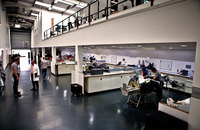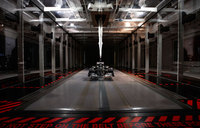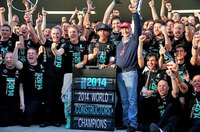MB Takes F1 Technology From Winner's Circle To The Road | Part Two
By Henny Hemmes
Senior European Editor
The Auto Channel
This past summer, I visited the development center of the Mercedes AMG Petronas Formula 1-team in Brackley, England. There the engineers explained about their ongoing search for performance and efficiency. The first part of this story focused on he exchange of hybrid technology between the world-class engineers of Mercedes and the F1-team, and vice versa. But there is more F1 technology that Mercedes-Benz is bringing to the roads.
We are well aware that the car industry is developing smaller engines and this also goes for Formula 1. Thanks to new regulations that FIA has introduced this year, the siz of the engines has been drastically reduced.
The development for the 2014 F1 season began already in 2011 with external suppliers, but Mercedes decided to take it in-house. The performance targets and 2014-deadline accelerated the development of specific development tools such s a gas stand installation at Mercedes AMG High Performance Powertains in Brixworth.
Challenges were numerous: “The old F1 V8 engine lost 18 per cent of its energy output to friction,” said Dr. Paul Crofts, head of materials engineering at Mercedes AMG High performance power trains. “but with the new engine that has been reduced to 15 per cent.”
 |
Such losses are due to friction and lubrication and that is why many teams of engineers worked in tandem to focus on different technologies. One, for instance, was addressing the issue of lubrication. The F1 team developed together with sponsor Petronas over 50 oils for engine, transmission and hydraulic systems. The cooperation between the two companies grew into a strategic business alliance and that way Mercedes-Benz extended the partnership from the track to the road: to the high performance AMG models.
 |
Then, there is the chapter of aerodynamics. Starting this year, the FIA has reduced downforce of the race cars with 25 per cent. This is a real punishment for race cars, but thanks to wind tunnel test the design can be adjusted for the optimal combination of air resistance and downforce.
 |
 |
 |
As far back as 1968, D.M. Peters wrote in his article in Design Engineering about CFRP as ‘the material that may revolutionize aircraft design’. He was right. Today, 50 percent of the fuselage and wing components of the Boeing 787 Dreamliner are made of CFRP.
But today the material is also changing the car industry which is focusing on minimizing its exhaust emissions and its overall carbon footprint.
 |
Mercedes started using the very expensive material in the R230, the 2001 SL-Class Roadster and McLaren uses it since 2004 for components of the SLR McLaren supercar. BMW started using CFRP for the hood of its M3 in the early 2000s and in 2009 established a joint venture for the production of fibers and semi-finished CFRP products for use in their then not yet unveiled BMW i-models, the electric i3 and the i8 hybrids sports car. Others are also using ‘carbon’ components, such as Chevrolet that introduced Corvette ZO6 Carbon limited edition in 2011.
Nowadays, the exchange of knowledge has become daily routine for Mark Ellis, Performance Director of the team in Brackney, and Professor Ludger Dragon, his counterpart in Germany. The lack of miles on the track is compensated by the engineers by driving simulations and the experience of their colleagues. It may be no surprise that also the F1-drivers are practicing their skills in race simulators for many more hours than before..
 |
With respect to F1 racing, the result is known: Mercedes won the Constructor’s Championship, while AMG Petronas drivers Hamilton and Rosberg secured a one-two finish in the Driver’s Championship. Mercedes is now the fourth most valuable F1 team, worth an estimated $560 million.
MORE: Part One



